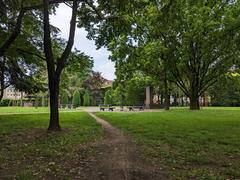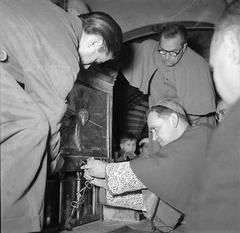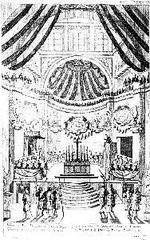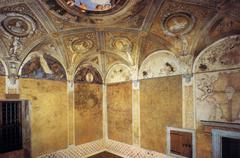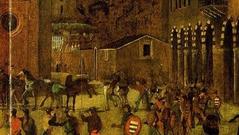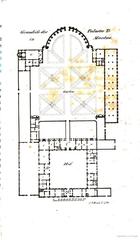Palazzo Ducale Mantua: Comprehensive Guide to Visiting Hours, Tickets, and Historical Insights
Date: 14/06/2025
Introduction
The Palazzo Ducale in Mantua, Italy, is a monumental palace complex that stands as a testament to the city’s illustrious Renaissance past. Renowned for its architectural grandeur, extensive art collections, and its role as the seat of the influential Gonzaga dynasty, the palace is a cornerstone of Mantua’s cultural and historical identity. This detailed guide covers everything you need to know to plan your visit—including historical context, visiting hours, ticketing, accessibility, guided tours, and practical tips—ensuring you make the most of your exploration of one of Italy’s most significant historical sites.
(Italia.it) (Mantovalab Polimi)
Table of Contents
- History and Significance
- Architectural and Artistic Highlights
- Visitor Information
- Frequently Asked Questions (FAQ)
- Summary and Recommendations
- Sources and Further Reading
History and Significance
The Gonzaga Dynasty and the Palace’s Origins
The Palazzo Ducale’s origins date back to the late 13th century, initially constructed by the Bonacolsi family. Following the rise of the Gonzaga family in 1328, the palace underwent continuous expansion and embellishment, reflecting the dynasty’s political power and cultural ambitions. Over the centuries, the complex grew to encompass more than 500 rooms, seven gardens, and eight courtyards, solidifying Mantua’s status as a Renaissance cultural hub (Mantovalab Polimi; Wikipedia).
Artistic Legacy
The Gonzagas were renowned patrons of the arts, commissioning works from masters such as Andrea Mantegna, whose Camera degli Sposi set new standards for illusionistic fresco painting. Other luminaries associated with the palace include Pisanello, Giulio Romano, and Peter Paul Rubens. The palace not only served as a residence but also as a center for political events, religious ceremonies, and artistic innovation (Andrea Concas; Guidaturistica Mantova Verona).
UNESCO World Heritage Status
In 2008, the Palazzo Ducale, along with Mantua’s old town and Sabbioneta, was designated a UNESCO World Heritage Site for its exceptional Renaissance urban planning and the enduring legacy of the Gonzaga family (UNESCO).
Architectural and Artistic Highlights
Palace Layout and Key Sections
- Corte Vecchia (Old Court): The original medieval core, expanded during the Renaissance.
- Corte Nuova (New Court): 16th-century additions reflecting evolving tastes.
- Castello di San Giorgio (St. George’s Castle): A fortified section housing the Camera degli Sposi.
- Gardens and Courtyards: Seven gardens and eight courtyards, offering tranquil settings and architectural variety (Italia.it; in-Lombardia).
Artistic Masterpieces
- Camera degli Sposi: Andrea Mantegna’s frescoes (1465–1474) in the Castello di San Giorgio are considered a pinnacle of Renaissance art, celebrated for their lifelike portraits and illusionistic ceiling (Italia.it).
- Palatine Basilica of Santa Barbara: Designed by Giovanni Battista Bertani; features works by Lorenzo Costa the Younger and Domenico Riccio.
- Other Notable Collections: The palace houses works by Pisanello, Rubens, and Giulio Romano, as well as archaeological and contemporary art displays (CultureActivities).
Architectural Styles
The complex represents a unique fusion of medieval, Renaissance, and Baroque styles—arcaded porticos, frescoed vaults, grand staircases, and harmonious garden integration echo the ideals of unity between architecture and nature (in-Lombardia).
Visitor Information
Location and Getting There
- Address: Piazza Sordello, 40, 46100 Mantova MN, Italy
(Mantova Ducale Official) - By Train: 15-minute walk from Mantua’s train station.
- By Car: Paid parking in the center; consider peripheral lots if central spaces are full.
- By Bus: Urban and extra-urban lines connect Mantua with surrounding areas. The Mantova + Sabbioneta Card includes public transport (Mantova Card).
Visiting Hours
- Open: Tuesday to Sunday, 8:15 AM – 7:15 PM (last entry 6:20 PM)
- Closed: Mondays, December 25, January 1, May 1
- Ticket Office: 8:15 AM – 6:15 PM
- Bookshop: Tuesday–Sunday, 10:00 AM – 7:00 PM
(MantovaDucale Opening Hours)
Special Openings
Occasional late-night events and summer evening openings (see official calendar).
Tickets and Admission
- Standard Admission: ~€15 (adults)
- Reductions: EU citizens 18–25, teachers, and other categories
- Free Entry: Under 18, disabled visitors and companion
- Camera degli Sposi Supplement: €5.50
- Mantova + Sabbioneta Card: €25 (adults), €13 (12–17), includes multiple attractions and transport
(MantovaDucale Tickets; Mantova Card)
Booking: Strongly recommended, especially for the Camera degli Sposi due to limited slots. Tickets can be purchased online via Vivaticket or at the entrance.
Guided Tours and Audio Guides
- Guided Tours: Available in Italian on weekends, with private group options in multiple languages. Book via call center (+39 041-2411897 / +39 049-2010262).
- Audio Guides: Check availability at the ticket office for self-guided exploration.
Accessibility
- Many areas are accessible to visitors with reduced mobility; some historic rooms may have limited access due to stairs or uneven floors.
- Contact infopoint (+39 0376 352100) for detailed information and assistance (MantovaDucale Accessibility).
Visitor Tips
- Best Times: Spring and autumn, or weekday mornings/late afternoons for fewer crowds.
- Duration: Allocate 2–3 hours for main highlights; 4–5 hours for a comprehensive visit.
- Dress Comfortably: Wear suitable shoes for extensive walking.
- Photography: Allowed without flash or tripods in most areas; restrictions apply in some rooms, especially the Camera degli Sposi.
- Large Bags: May need to be checked at the cloakroom.
Amenities
- Bookshop: Sells guides, souvenirs, and art books.
- Cafés: Available in Piazza Sordello and nearby streets, as there are no cafés inside the palace.
- Restrooms and Cloakroom: On site.
Nearby Attractions
- Palazzo Te: Giulio Romano’s Mannerist masterpiece, a short walk from the Ducal Palace.
- Basilica of Sant’Andrea: Renaissance church housing relics and works of art.
- Piazza Sordello: Historic main square adjacent to the palace.
- Mantua Cathedral: Worth visiting for its impressive architecture and artworks.
(Italo Blog)
Frequently Asked Questions (FAQ)
Q: What are the Palazzo Ducale Mantua opening hours?
A: Tuesday–Sunday, 8:15 AM–7:15 PM (last entry 6:20 PM); closed Mondays and holidays.
Q: Where can I buy tickets?
A: Online via Vivaticket or at the on-site ticket office.
Q: Are guided tours available?
A: Yes, both scheduled and private tours are offered in multiple languages; audio guides are available.
Q: Is the palace wheelchair accessible?
A: Many sections are accessible, but some areas have limited access; contact the infopoint for details.
Q: Can I take photos inside?
A: Photography is generally allowed without flash or tripods, but some rooms, such as the Camera degli Sposi, may have restrictions.
Q: What is the Mantova + Sabbioneta Card?
A: A city pass granting entry to major attractions, public transport, and discounts—ideal for comprehensive city exploration (Mantova Card).
Summary and Recommendations
The Palazzo Ducale Mantua offers an unparalleled journey through centuries of art, history, and architecture. From the breathtaking frescoes of the Camera degli Sposi to lush Renaissance gardens and the palace’s imposing medieval towers, visitors experience the grandeur and sophistication of the Gonzaga court.
Plan ahead by booking tickets—especially for the Camera degli Sposi—consider the Mantova + Sabbioneta Card for additional savings, and allow ample time to explore both the palace and Mantua’s other historic sites.
Key tips:
- Book tickets in advance, particularly during peak periods and free-entry Sundays.
- Wear comfortable shoes and be prepared for extensive walking.
- Combine your visit with Palazzo Te and other local landmarks for a richer experience.
For further planning, download the Audiala app for guided tours, maps, and updates, and consult the official palace website for the latest visitor information.
Sources and Further Reading
- Ducal palace, Mantua, Wikipedia
- The Gonzagas palace: architecture of time, Mantovalab Polimi, 2016
- Ducal Palace, Spotting History
- Licensed Local Guide Mantua Mantua Tourist guide, Guidaturistica Mantova Verona
- Tourism in Lombardy - Tourism Mantua, In-Lombardia
- Duсal Palace Museum Mantua, Andrea Concas
- Ducal Palace of Mantua, Italia.it
- What to see in Mantua in one day, Italo Blog
- Mantova Ducale Official Website
- Mantova Card
- Nomadic Niko, Ducal Palace Mantua
- UNESCO World Heritage – Mantua and Sabbioneta
- Bella Italia Goods, Mantua Italy: A Journey Through History and Culture
- Monday Feelings, What to Do in Mantua
- Travel To Italy Guide, What to See at the Palazzo Ducale Mantua
- The Italy Edit, Mantova Travel Guide
- Culture Activities, Things to do in Mantua
- National Traveller, Visit to the Ducal Palace in Mantua - Times, Prices and Advice

